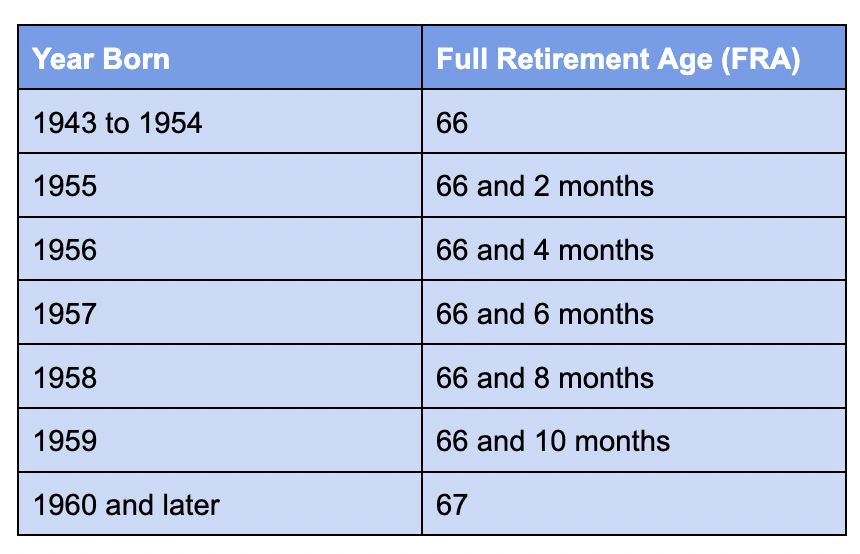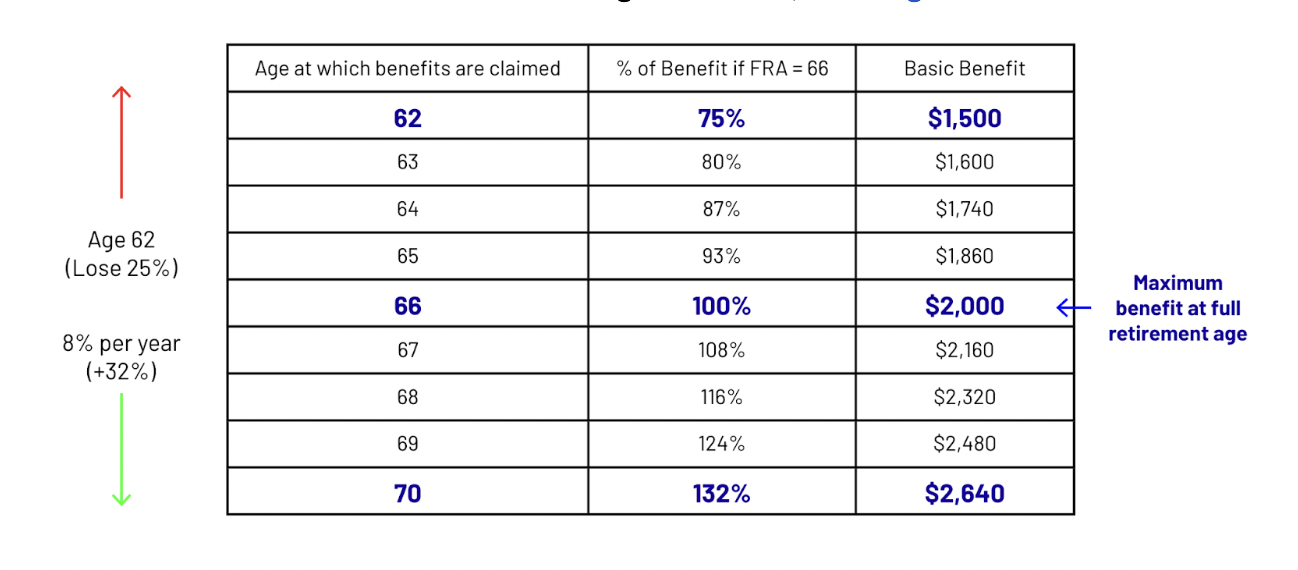
By Scott Hamilton, CFP®
The years leading up to retirement can feel overwhelming for many people. You might be eager for this next chapter yet uncertain about how to navigate the transition—especially when it comes to Social Security. It’s easy to feel like everyone but you has it all figured out.
The post-pandemic shift, including the Great Resignation of 2021 and 2022, has reshaped the workforce, making it more important than ever to understand how Social Security fits into your retirement plan.
This comprehensive guide is designed to help you gain clarity and confidence so you can optimize your benefits and step into retirement feeling fully prepared.
Table of Contents
How Are Social Security Benefits Calculated?
Your Social Security benefits are calculated by the Social Security Administration (SSA). Benefits are based on lifetime earnings across your 35 highest earning years. You must work a minimum of 10 years to be eligible for benefits. If you have worked less than 35 years, your earnings will be calculated with zeros for the years you have not worked. All past wages are indexed to today’s wages in order to accurately reflect wage growth.
Once your average monthly earnings for your top 35 years are calculated, a special formula is applied and the result is your primary insurance amount (PIA). The PIA is the benefit you are eligible to receive when you reach full retirement age (FRA).
The actual benefit you receive may not be your PIA. This is because your PIA will be increased or decreased depending on when you choose to receive benefits. Taking benefits before FRA will reduce your benefit, and waiting until after FRA will increase your monthly benefit. Also, starting at age 62, your eligible benefits will receive regular cost-of-living adjustments (COLA).
Spousal Benefits
Married people are eligible for benefits based on their spouse’s work history. The spousal benefit is 50% of the working spouse’s earned benefit. In order to receive these benefits, the working spouse must be at least 62 and have already filed for benefits.
If you are divorced, you may also be eligible to receive spousal benefits based on your ex-spouse’s work history. Your marriage needs to have lasted at least 10 years, you must be divorced for at least two years, and you must still be single. In addition, you need to be at least 62 and not eligible for a higher benefit amount based on your own work record. Unlike spousal benefits for married people, your ex-spouse does not need to have filed for benefits in order for you to claim them.
When Can You Claim Social Security Benefits?
You can claim your Social Security benefits anytime between age 62 and age 70. If you continue to delay taking benefits after you reach age 70, there is no additional benefit increase. However, the age at which you choose to collect benefits before 70 will impact the amount of benefit you receive.
Early Retirement
You can start receiving benefits as early as 62, but your monthly benefit will be lower than if you waited longer. Your basic benefit is reduced a fraction of a percent for each month you begin receiving benefits prior to full retirement age. Retiring early can permanently reduce your benefit by up to 30%.
Full Retirement Age
Your full retirement age (FRA) changes based on the year you were born. FRA is 66 for those born between 1943 and 1954 and increases by two months for every year after that you were born until it settles at age 67 for those born in 1960 or later. If you wait until you reach full retirement age to begin collecting your Social Security benefits, you will receive the full PIA that you have earned.

Delayed Benefits
If you’re still working or don’t need the money immediately, you can delay receiving your benefits. Your benefit will increase by 8% for each year that you delay, with a maximum possible increase of 32%. You cannot delay and increase your benefit indefinitely, though. Once you reach age 70, the amount of benefits you receive will not increase any further.
When Is the Best Time to Claim Social Security Benefits?
Your Social Security benefit is based on your 35 highest-earning years, so continuing to work and earning a higher salary can replace lower-earning years in your calculation, ultimately increasing your future benefit. Once you stop working, your benefit amount is set based on your earnings record, but your claiming age still plays a vital role. Claiming benefits before full retirement age reduces your monthly payments, while delaying benefits beyond FRA can increase them by up to 8% per year until age 70. Understanding these factors can help you make a more informed decision about when to claim.
Social Security Statement
An important document that you will reference during the decision-making process is your Social Security statement. The Social Security Administration mails statements to workers age 60 and over who aren’t receiving Social Security benefits and do not yet have a my Social Security account. These statements will be mailed out three months prior to your birthday, but you can also access the same information by setting up an account on their website.
The statement will tell you your:
- Estimated benefit if taken at age 62
- Estimated benefit if taken at FRA
- Estimated benefit if taken at age 70
- Estimated disability benefit
- Estimated family and survivor benefits
- Medicare information
- Earnings history
All benefit amounts listed are estimates and subject to change. They are calculated based on your date of birth and future estimated taxable earnings.
It is important to review your earnings history and check for accuracy. Your benefit is calculated based on those numbers, so any mistakes can affect your benefits. You should correct any errors as soon as possible.
Deciding When to Claim Benefits
Your Social Security benefits are calculated using complex actuarial equations based on life expectancy and estimated rates of return. They are not designed to encourage early or late retirement. If you live as long as anticipated, the total amount you receive over your lifetime should be about the same whether you claim it at age 62, age 70, or sometime in between. You will either receive the money as a smaller monthly payment over a longer period of time or a larger monthly payment over a shorter period of time.
The best time for you to claim your benefits depends on your personal situation and health. If you expect to live longer than average, your overall lifetime benefit will be greater if you delay claiming your benefits to increase your benefit amount. If the opposite is true and you see little chance of making it into your mid-80s, you would likely receive a greater lifetime benefit by taking it sooner, even though it would be a smaller monthly payment.
When to Start Benefits: The Longer You Wait, the Larger the Benefit

Once you decide when you want to start receiving benefits, remember to complete your application three months before the month in which you want your retirement benefits to begin.
How Can Married Couples Maximize Benefits?
Because married people have the ability to receive their own benefit or a spousal benefit, they have more to consider when filing for benefits. With the right strategy, married couples can maximize their benefits.
In the majority of cases, the lower-earning spouse may want to begin collecting benefits early while the higher-earning spouse waits as long as possible. That way, you can access the lesser benefit while maximizing the higher benefit.
Often, it is the husband with the higher benefit and the wife with the lower one. Women also tend to live longer than men. By following this strategy of waiting as long as possible to claim the higher benefit, you not only maximize the husband’s retirement benefit for use while he is alive, but it also maximizes the wife’s survivor benefit when he passes away.
Restricted Application (No Longer Available)
Once a popular way to maximize Social Security benefits, this strategy is now only available to those born before January 2, 1954. Since everyone who qualified would now be at least 70 and likely already claiming benefits, this option is no longer actionable for new retirees. However, understanding past claiming strategies highlights how Social Security rules have evolved over time, reinforcing the importance of staying informed about current options.
How Does Working Affect Benefits?
Working does not affect your benefits once you reach FRA, but it does before that. Only earned income, such as wages and self-employment earnings, affects your Social Security benefits. Income from investments, pensions, and annuities do not affect Social Security benefits.
When you are under FRA for the whole year, your Social Security benefit is reduced by $1 for every $2 you earn over $21,240. In the year that you reach FRA, your benefit is reduced by $1 for every $3 you earn over $56,520. Once you reach FRA, your benefit is no longer reduced no matter how much you earn. These dollar amounts adjust each year, so your benefit may change in following years.
2025 Cost-of-Living Adjustment
The 2025 COLA is 2.5%, slightly lower than 2024’s increase of 3.2%. There is also an increase in the Social Security tax cap. The cap is increased from $160,200 to $168,600, meaning Social Security taxes will not be withheld from income earned above that amount.
This substantial increase in benefits will hopefully provide retirees some relief from the rising cost of goods and services. Historically, a COLA that fails to keep pace with inflation only serves to exacerbate financial hardships. It’s important to keep in mind that the COLA will affect pre-retirees and retirees differently. Here’s what to expect based on where you are in your retirement journey.
Retirees Taking Social Security
While this increase is good news for retirees, it’s not a license to change spending habits all that much—as most retirees know all too well.
It will still be necessary to keep track of your finances, spending—and, importantly, your tax liabilities; some beneficiaries could experience increased taxes in the coming years, depending on their thresholds.
Retirees Not Taking Social Security
Retirees who have not started claiming Social Security will still reap the benefits of this increase even if they don’t take Social Security this year. There is never a decrease in the COLA, so the higher payments are here to stay.
Additionally, the recent elimination of the Pension Offset and Windfall provisions has provided new opportunities for many government workers. These provisions previously reduced Social Security benefits for individuals with pensions from non-Social Security-covered employment. With their removal, affected workers can now receive their full Social Security benefits without reduction, significantly enhancing their financial security during retirement. This change is particularly important for those who have spent significant time in government roles, allowing them to enjoy the benefits they’ve earned.
Keep in mind that, in some cases, it’s worth holding off on taking Social Security for several years once you’re eligible, as discussed above. Of course, the benefits of doing so vary based on individual circumstances.
Partner With a Seasoned Advisor
The timing and strategy behind claiming your Social Security benefits can be one of the most critical decisions you make in retirement—especially depending on your savings. Given the complexity and long-term impact of this choice, consulting a financial professional can provide clarity and confidence for your future.
At Hamilton Financial Planning, LLC, we guide individuals like you through the Social Security process to help you make informed decisions that align with your overall retirement plan. Are you approaching retirement and have questions about how Social Security fits into your financial future? Schedule a complimentary get-acquainted meeting online or reach out to us at 512-261-0808 or scott@hamiltonfinancialplanning.com.
About Scott
Scott Hamilton is founder and chief financial officer at Hamilton Financial Planning, a wealth management firm that specializes in providing comprehensive financial planning for retirees. With over 20 years of experience in the financial industry, and having completed over 250 financial plans for retirees across all industries, but mostly the oil and gas industry, Scott is passionate about providing his clients with the tools and insight they need to achieve their financial goals. He has a Bachelor of Business Administration in finance from Texas State University and an MBA in international finance from Pepperdine University. Scott has also been happily married to his wife, Gayle, for over 25 years. To learn more about Scott, connect with him on LinkedIn.

